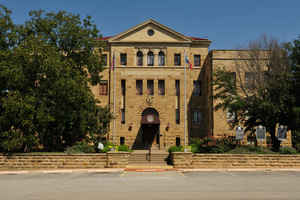Texas Counties
Texas is divided into two hundred and fifty-four counties, more than any other state. Texas was originally divided into municipalities, a unit of local government under Spanish and Mexican rule. When the Republic of Texas gained its independence in 1836, there were 23 municipalities, which became the original Texas counties. Many of these would later be divided into new counties. The most recent county to be created was Kenedy County in 1921. The most recent county to be organized was Loving County in 1931Palo Pinto County, Texas
Palo Pinto County Education, Geography, and History

Palo Pinto County is a county located in the state of Texas. Based on the 2010 census, its population was 28,111. The county seat is Palo
Pinto. The county was created in 1856 and organized the following year.
Palo Pinto County comprises the Mineral Wells, TX Micropolitan Statistical Area, which is part of the Dallas-Fort Worth, TX Combined
Statistical Area. It is located in the Western Cross Timbers Ecoregion.
Etymology - Origin of Palo Pinto County Name
Palo Pinto Creek (Palo Pinto is Spanish for painted stick)
Demographics:
County QuickFacts: CensusBureau Quick Facts
Palo Pinto County History
The Brazos Indian Reservation, founded by General Randolph B. Marcy in 1854, provided a safety area from warring
Comanche for Delaware, Shawnee, Tonkawa, Wichita, and Caddo. Within the reservation, each tribe had its own village and cultivated
agricultural crops. Government-contracted beeves were delivered each week. Citizens were unable to distinguish between reservation and
non-reservation tribes, blaming Comanche and Kiowa depredations on the reservation Indians. A newspaper in Jacksboro, Texas titled The White
Man advocated removal of all tribes from north Texas.
During December 1858, Choctaw Tom, at times an interpreter to Sam Houston, and a group of reservation Indians received permission for an
off-the-reservation hunt. On December 27, Captain Peter Garland and a vigilante group charged Choctaw Tom's camp, indiscriminately murdering
and injuring women and children along with the men. Citizens feared retribution from reservations tribes.
Governor Hardin Richard Runnels ordered John Henry Brown to the area with 100 troops. An examining trial was conducted about the Choctaw Tom
raid, but no indictments resulted.
May 1859, John Baylor and a number of whites confronted United States troops at the reservation, demanding the surrender of certain tribal
individuals. The military balked, and Baylor retreated, but in so doing killed an Indian woman and an old man. Baylor's group was later
attacked by Indians off the reservation, where the military had no authority to intervene. At the behest of terrified settlers, the
reservation was abandoned that year.
In 1856 the Texas state legislature established Palo Pinto County from Bosque and Navarro counties and named for Palo Pinto Creek. The county
was organized the next year, with the town of Golconda chosen to be the seat of government. The town was renamed Palo Pinto in 1858.
Handbook of Texas Online
In 1856 the Texas state legislature established Palo Pinto County from lands formerly assigned to Bosque and
Navarro counties. The county was organized the next year, with the town of Golconda chosen to be the seat of
government. The town was renamed Palo Pinto in 1858. One of the first businesses in the county, an ox treadmill, was
established that year. By 1860 there were 1,524 people, including 130 slaves, living in the county. Almost 15,400
cattle and more than 3,200 sheep were counted on Palo Pinto ranches and farms that year. Farmers grew mostly corn,
wheat, and oats, although seventeen bales of cotton were also produced. Though crop farming was becoming better
established in the area, the area's economy centered around cattle in the years just after the Civil War.
In 1867 cattlemen Oliver Loving and Charles Goodnight established the famed Goodnight-Loving Trail
to western markets. In 1876 C. C. Slaughter, James C. Loving, and C. L. "Kit"
Carter met to discuss the theft of cattle by reservation Indians and white rustlers, and the challenge to their open
range by new settlers. Out of this meeting on Slaughter's ranch grew the organizational meeting, held at Graham the
next year, of the Stock Raiser's Association of Northwest Texas, later known as the Texas and Southwestern Cattle
Raisers Association. Carter, of Palo Pinto, was the association's first
president. In the late 1870s and early 1880s some ranchmen began fencing rangeland to which they held title. Some
settlers opposed fencing of the traditionally free open range, and incidents of fence cutting
and violence resulted (see also BARBED WIRE). By 1880 there were 648 farms and ranches in Palo Pinto County;
of these, 476 were operated by their owners, 28 were operated by renters, and 144 were farmed by sharecroppers. Over
9,300 acres in the county were planted in corn, the county's most important crop at that time, with another 2,425
acres devoted to wheat. Cotton was becoming an important cash crop, and 4,300 acres in the county were devoted to
the fiber. As cropland in the county expanded, so did the number of livestock: by 1880 there were 42,400 cattle and
5,000 sheep grazing in the county. Nine manufacturing businesses, employing twenty workers, had been established in
the county. The area's expanding population reflected its economic growth, as the census counted 5,882 people living
in Palo Pinto County that year More at
John Leffler, "PALO PINTO COUNTY," Handbook of Texas Online (http://www.tshaonline.org/handbook/online/articles/hcp01),
accessed January 24, 2016. Uploaded on June 15, 2010. Published by the Texas State Historical Association.
Geography: Land and Water
As reported by the Census Bureau, the county has a total area of 986 square miles (2,552 km2), of which, 953
square miles (2,468 km2) of it is land and 33 square miles (84 km2) of it (3.30%) is water.
Neighboring Counties
Bordering counties are as follows:
- Jack County (north)
- Parker County (east)
- Hood County (southeast)
- Erath County (south)
- Eastland County (southwest)
- Stephens County (west)
- Young County (northwest)
Education







